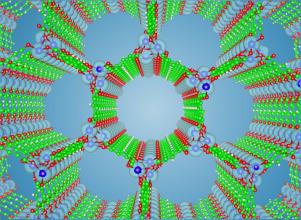求助PDF
{"title":"MOF-74金属有机骨架的电子性质和ORR/OER催化活性的理论研究","authors":"Victor Hoyos-Sinchi, Walter Orellana","doi":"10.1016/j.electacta.2025.147371","DOIUrl":null,"url":null,"abstract":"The electronic properties and catalytic activity for the oxygen reduction reaction (ORR) and oxygen evolution reaction (OER) of the metal–organic frameworks <span><span style=\"\"></span><span data-mathml='<math xmlns=\"http://www.w3.org/1998/Math/MathML\"><mi is=\"true\">M</mi></math>' role=\"presentation\" style=\"font-size: 90%; display: inline-block; position: relative;\" tabindex=\"0\"><svg aria-hidden=\"true\" focusable=\"false\" height=\"1.971ex\" role=\"img\" style=\"vertical-align: -0.235ex;\" viewbox=\"0 -747.2 1051.5 848.5\" width=\"2.442ex\" xmlns:xlink=\"http://www.w3.org/1999/xlink\"><g fill=\"currentColor\" stroke=\"currentColor\" stroke-width=\"0\" transform=\"matrix(1 0 0 -1 0 0)\"><g is=\"true\"><use xlink:href=\"#MJMATHI-4D\"></use></g></g></svg><span role=\"presentation\"><math xmlns=\"http://www.w3.org/1998/Math/MathML\"><mi is=\"true\">M</mi></math></span></span><script type=\"math/mml\"><math><mi is=\"true\">M</mi></math></script></span>-MOF-74, where <span><span style=\"\"></span><span data-mathml='<math xmlns=\"http://www.w3.org/1998/Math/MathML\"><mi is=\"true\">M</mi></math>' role=\"presentation\" style=\"font-size: 90%; display: inline-block; position: relative;\" tabindex=\"0\"><svg aria-hidden=\"true\" focusable=\"false\" height=\"1.971ex\" role=\"img\" style=\"vertical-align: -0.235ex;\" viewbox=\"0 -747.2 1051.5 848.5\" width=\"2.442ex\" xmlns:xlink=\"http://www.w3.org/1999/xlink\"><g fill=\"currentColor\" stroke=\"currentColor\" stroke-width=\"0\" transform=\"matrix(1 0 0 -1 0 0)\"><g is=\"true\"><use xlink:href=\"#MJMATHI-4D\"></use></g></g></svg><span role=\"presentation\"><math xmlns=\"http://www.w3.org/1998/Math/MathML\"><mi is=\"true\">M</mi></math></span></span><script type=\"math/mml\"><math><mi is=\"true\">M</mi></math></script></span> = Cr, Mn, Fe, Co, Ni, and Cu, were investigated using density functional theory calculations. The ORR/OER activity was assessed by evaluating the adsorption free energy of reaction intermediates on the metal centers, following the computational hydrogen electrode method. Our findings reveal that all <span><span style=\"\"></span><span data-mathml='<math xmlns=\"http://www.w3.org/1998/Math/MathML\"><mi is=\"true\">M</mi></math>' role=\"presentation\" style=\"font-size: 90%; display: inline-block; position: relative;\" tabindex=\"0\"><svg aria-hidden=\"true\" focusable=\"false\" height=\"1.971ex\" role=\"img\" style=\"vertical-align: -0.235ex;\" viewbox=\"0 -747.2 1051.5 848.5\" width=\"2.442ex\" xmlns:xlink=\"http://www.w3.org/1999/xlink\"><g fill=\"currentColor\" stroke=\"currentColor\" stroke-width=\"0\" transform=\"matrix(1 0 0 -1 0 0)\"><g is=\"true\"><use xlink:href=\"#MJMATHI-4D\"></use></g></g></svg><span role=\"presentation\"><math xmlns=\"http://www.w3.org/1998/Math/MathML\"><mi is=\"true\">M</mi></math></span></span><script type=\"math/mml\"><math><mi is=\"true\">M</mi></math></script></span>-MOF-74 structures exhibit band gap energies of approximately 2 eV and high-spin magnetic moments per metal atom with a ferromagnetic ground state. In terms of catalytic performance, Cr-MOF-74 and Fe-MOF-74 show outstanding ORR activity, with overpotentials around 0.5 V. Notably, Mn-MOF-74 and Ni-MOF-74 exhibit bifunctional ORR/OER activity, meaning they can catalyze both reactions simultaneously, with similar overpotentials of approximately 0.7 V. These ORR and OER overpotentials are comparable to those found on Pt(111) and IrO<span><span style=\"\"></span><span data-mathml='<math xmlns=\"http://www.w3.org/1998/Math/MathML\"><msub is=\"true\"><mrow is=\"true\" /><mrow is=\"true\"><mn is=\"true\">2</mn></mrow></msub></math>' role=\"presentation\" style=\"font-size: 90%; display: inline-block; position: relative;\" tabindex=\"0\"><svg aria-hidden=\"true\" focusable=\"false\" height=\"1.509ex\" role=\"img\" style=\"vertical-align: -0.582ex;\" viewbox=\"0 -399.4 453.9 649.8\" width=\"1.054ex\" xmlns:xlink=\"http://www.w3.org/1999/xlink\"><g fill=\"currentColor\" stroke=\"currentColor\" stroke-width=\"0\" transform=\"matrix(1 0 0 -1 0 0)\"><g is=\"true\"><g is=\"true\"></g><g is=\"true\" transform=\"translate(0,-150)\"><g is=\"true\"><use transform=\"scale(0.707)\" xlink:href=\"#MJMAIN-32\"></use></g></g></g></g></svg><span role=\"presentation\"><math xmlns=\"http://www.w3.org/1998/Math/MathML\"><msub is=\"true\"><mrow is=\"true\"></mrow><mrow is=\"true\"><mn is=\"true\">2</mn></mrow></msub></math></span></span><script type=\"math/mml\"><math><msub is=\"true\"><mrow is=\"true\"></mrow><mrow is=\"true\"><mn is=\"true\">2</mn></mrow></msub></math></script></span>(110) surfaces, which are the most effective commercial electrocatalysts for the respective reactions. Additionally, the ORR/OER performance of <span><span style=\"\"></span><span data-mathml='<math xmlns=\"http://www.w3.org/1998/Math/MathML\"><mi is=\"true\">M</mi></math>' role=\"presentation\" style=\"font-size: 90%; display: inline-block; position: relative;\" tabindex=\"0\"><svg aria-hidden=\"true\" focusable=\"false\" height=\"1.971ex\" role=\"img\" style=\"vertical-align: -0.235ex;\" viewbox=\"0 -747.2 1051.5 848.5\" width=\"2.442ex\" xmlns:xlink=\"http://www.w3.org/1999/xlink\"><g fill=\"currentColor\" stroke=\"currentColor\" stroke-width=\"0\" transform=\"matrix(1 0 0 -1 0 0)\"><g is=\"true\"><use xlink:href=\"#MJMATHI-4D\"></use></g></g></svg><span role=\"presentation\"><math xmlns=\"http://www.w3.org/1998/Math/MathML\"><mi is=\"true\">M</mi></math></span></span><script type=\"math/mml\"><math><mi is=\"true\">M</mi></math></script></span>-MOF-74 is analyzed using catalytic descriptors, providing deeper insights into its electronic structure and the adsorption behavior of reaction intermediates.","PeriodicalId":305,"journal":{"name":"Electrochimica Acta","volume":"14 1","pages":""},"PeriodicalIF":5.6000,"publicationDate":"2025-09-17","publicationTypes":"Journal Article","fieldsOfStudy":null,"isOpenAccess":false,"openAccessPdf":"","citationCount":"0","resultStr":"{\"title\":\"Electronic properties and ORR/OER catalytic activity of MOF-74 metal-organic frameworks: A theoretical study\",\"authors\":\"Victor Hoyos-Sinchi, Walter Orellana\",\"doi\":\"10.1016/j.electacta.2025.147371\",\"DOIUrl\":null,\"url\":null,\"abstract\":\"The electronic properties and catalytic activity for the oxygen reduction reaction (ORR) and oxygen evolution reaction (OER) of the metal–organic frameworks <span><span style=\\\"\\\"></span><span data-mathml='<math xmlns=\\\"http://www.w3.org/1998/Math/MathML\\\"><mi is=\\\"true\\\">M</mi></math>' role=\\\"presentation\\\" style=\\\"font-size: 90%; display: inline-block; position: relative;\\\" tabindex=\\\"0\\\"><svg aria-hidden=\\\"true\\\" focusable=\\\"false\\\" height=\\\"1.971ex\\\" role=\\\"img\\\" style=\\\"vertical-align: -0.235ex;\\\" viewbox=\\\"0 -747.2 1051.5 848.5\\\" width=\\\"2.442ex\\\" xmlns:xlink=\\\"http://www.w3.org/1999/xlink\\\"><g fill=\\\"currentColor\\\" stroke=\\\"currentColor\\\" stroke-width=\\\"0\\\" transform=\\\"matrix(1 0 0 -1 0 0)\\\"><g is=\\\"true\\\"><use xlink:href=\\\"#MJMATHI-4D\\\"></use></g></g></svg><span role=\\\"presentation\\\"><math xmlns=\\\"http://www.w3.org/1998/Math/MathML\\\"><mi is=\\\"true\\\">M</mi></math></span></span><script type=\\\"math/mml\\\"><math><mi is=\\\"true\\\">M</mi></math></script></span>-MOF-74, where <span><span style=\\\"\\\"></span><span data-mathml='<math xmlns=\\\"http://www.w3.org/1998/Math/MathML\\\"><mi is=\\\"true\\\">M</mi></math>' role=\\\"presentation\\\" style=\\\"font-size: 90%; display: inline-block; position: relative;\\\" tabindex=\\\"0\\\"><svg aria-hidden=\\\"true\\\" focusable=\\\"false\\\" height=\\\"1.971ex\\\" role=\\\"img\\\" style=\\\"vertical-align: -0.235ex;\\\" viewbox=\\\"0 -747.2 1051.5 848.5\\\" width=\\\"2.442ex\\\" xmlns:xlink=\\\"http://www.w3.org/1999/xlink\\\"><g fill=\\\"currentColor\\\" stroke=\\\"currentColor\\\" stroke-width=\\\"0\\\" transform=\\\"matrix(1 0 0 -1 0 0)\\\"><g is=\\\"true\\\"><use xlink:href=\\\"#MJMATHI-4D\\\"></use></g></g></svg><span role=\\\"presentation\\\"><math xmlns=\\\"http://www.w3.org/1998/Math/MathML\\\"><mi is=\\\"true\\\">M</mi></math></span></span><script type=\\\"math/mml\\\"><math><mi is=\\\"true\\\">M</mi></math></script></span> = Cr, Mn, Fe, Co, Ni, and Cu, were investigated using density functional theory calculations. The ORR/OER activity was assessed by evaluating the adsorption free energy of reaction intermediates on the metal centers, following the computational hydrogen electrode method. Our findings reveal that all <span><span style=\\\"\\\"></span><span data-mathml='<math xmlns=\\\"http://www.w3.org/1998/Math/MathML\\\"><mi is=\\\"true\\\">M</mi></math>' role=\\\"presentation\\\" style=\\\"font-size: 90%; display: inline-block; position: relative;\\\" tabindex=\\\"0\\\"><svg aria-hidden=\\\"true\\\" focusable=\\\"false\\\" height=\\\"1.971ex\\\" role=\\\"img\\\" style=\\\"vertical-align: -0.235ex;\\\" viewbox=\\\"0 -747.2 1051.5 848.5\\\" width=\\\"2.442ex\\\" xmlns:xlink=\\\"http://www.w3.org/1999/xlink\\\"><g fill=\\\"currentColor\\\" stroke=\\\"currentColor\\\" stroke-width=\\\"0\\\" transform=\\\"matrix(1 0 0 -1 0 0)\\\"><g is=\\\"true\\\"><use xlink:href=\\\"#MJMATHI-4D\\\"></use></g></g></svg><span role=\\\"presentation\\\"><math xmlns=\\\"http://www.w3.org/1998/Math/MathML\\\"><mi is=\\\"true\\\">M</mi></math></span></span><script type=\\\"math/mml\\\"><math><mi is=\\\"true\\\">M</mi></math></script></span>-MOF-74 structures exhibit band gap energies of approximately 2 eV and high-spin magnetic moments per metal atom with a ferromagnetic ground state. In terms of catalytic performance, Cr-MOF-74 and Fe-MOF-74 show outstanding ORR activity, with overpotentials around 0.5 V. Notably, Mn-MOF-74 and Ni-MOF-74 exhibit bifunctional ORR/OER activity, meaning they can catalyze both reactions simultaneously, with similar overpotentials of approximately 0.7 V. These ORR and OER overpotentials are comparable to those found on Pt(111) and IrO<span><span style=\\\"\\\"></span><span data-mathml='<math xmlns=\\\"http://www.w3.org/1998/Math/MathML\\\"><msub is=\\\"true\\\"><mrow is=\\\"true\\\" /><mrow is=\\\"true\\\"><mn is=\\\"true\\\">2</mn></mrow></msub></math>' role=\\\"presentation\\\" style=\\\"font-size: 90%; display: inline-block; position: relative;\\\" tabindex=\\\"0\\\"><svg aria-hidden=\\\"true\\\" focusable=\\\"false\\\" height=\\\"1.509ex\\\" role=\\\"img\\\" style=\\\"vertical-align: -0.582ex;\\\" viewbox=\\\"0 -399.4 453.9 649.8\\\" width=\\\"1.054ex\\\" xmlns:xlink=\\\"http://www.w3.org/1999/xlink\\\"><g fill=\\\"currentColor\\\" stroke=\\\"currentColor\\\" stroke-width=\\\"0\\\" transform=\\\"matrix(1 0 0 -1 0 0)\\\"><g is=\\\"true\\\"><g is=\\\"true\\\"></g><g is=\\\"true\\\" transform=\\\"translate(0,-150)\\\"><g is=\\\"true\\\"><use transform=\\\"scale(0.707)\\\" xlink:href=\\\"#MJMAIN-32\\\"></use></g></g></g></g></svg><span role=\\\"presentation\\\"><math xmlns=\\\"http://www.w3.org/1998/Math/MathML\\\"><msub is=\\\"true\\\"><mrow is=\\\"true\\\"></mrow><mrow is=\\\"true\\\"><mn is=\\\"true\\\">2</mn></mrow></msub></math></span></span><script type=\\\"math/mml\\\"><math><msub is=\\\"true\\\"><mrow is=\\\"true\\\"></mrow><mrow is=\\\"true\\\"><mn is=\\\"true\\\">2</mn></mrow></msub></math></script></span>(110) surfaces, which are the most effective commercial electrocatalysts for the respective reactions. Additionally, the ORR/OER performance of <span><span style=\\\"\\\"></span><span data-mathml='<math xmlns=\\\"http://www.w3.org/1998/Math/MathML\\\"><mi is=\\\"true\\\">M</mi></math>' role=\\\"presentation\\\" style=\\\"font-size: 90%; display: inline-block; position: relative;\\\" tabindex=\\\"0\\\"><svg aria-hidden=\\\"true\\\" focusable=\\\"false\\\" height=\\\"1.971ex\\\" role=\\\"img\\\" style=\\\"vertical-align: -0.235ex;\\\" viewbox=\\\"0 -747.2 1051.5 848.5\\\" width=\\\"2.442ex\\\" xmlns:xlink=\\\"http://www.w3.org/1999/xlink\\\"><g fill=\\\"currentColor\\\" stroke=\\\"currentColor\\\" stroke-width=\\\"0\\\" transform=\\\"matrix(1 0 0 -1 0 0)\\\"><g is=\\\"true\\\"><use xlink:href=\\\"#MJMATHI-4D\\\"></use></g></g></svg><span role=\\\"presentation\\\"><math xmlns=\\\"http://www.w3.org/1998/Math/MathML\\\"><mi is=\\\"true\\\">M</mi></math></span></span><script type=\\\"math/mml\\\"><math><mi is=\\\"true\\\">M</mi></math></script></span>-MOF-74 is analyzed using catalytic descriptors, providing deeper insights into its electronic structure and the adsorption behavior of reaction intermediates.\",\"PeriodicalId\":305,\"journal\":{\"name\":\"Electrochimica Acta\",\"volume\":\"14 1\",\"pages\":\"\"},\"PeriodicalIF\":5.6000,\"publicationDate\":\"2025-09-17\",\"publicationTypes\":\"Journal Article\",\"fieldsOfStudy\":null,\"isOpenAccess\":false,\"openAccessPdf\":\"\",\"citationCount\":\"0\",\"resultStr\":null,\"platform\":\"Semanticscholar\",\"paperid\":null,\"PeriodicalName\":\"Electrochimica Acta\",\"FirstCategoryId\":\"88\",\"ListUrlMain\":\"https://doi.org/10.1016/j.electacta.2025.147371\",\"RegionNum\":3,\"RegionCategory\":\"材料科学\",\"ArticlePicture\":[],\"TitleCN\":null,\"AbstractTextCN\":null,\"PMCID\":null,\"EPubDate\":\"\",\"PubModel\":\"\",\"JCR\":\"Q1\",\"JCRName\":\"ELECTROCHEMISTRY\",\"Score\":null,\"Total\":0}","platform":"Semanticscholar","paperid":null,"PeriodicalName":"Electrochimica Acta","FirstCategoryId":"88","ListUrlMain":"https://doi.org/10.1016/j.electacta.2025.147371","RegionNum":3,"RegionCategory":"材料科学","ArticlePicture":[],"TitleCN":null,"AbstractTextCN":null,"PMCID":null,"EPubDate":"","PubModel":"","JCR":"Q1","JCRName":"ELECTROCHEMISTRY","Score":null,"Total":0}
引用次数: 0
引用
批量引用
Electronic properties and ORR/OER catalytic activity of MOF-74 metal-organic frameworks: A theoretical study
The electronic properties and catalytic activity for the oxygen reduction reaction (ORR) and oxygen evolution reaction (OER) of the metal–organic frameworks M M M 2 M


 求助内容:
求助内容: 应助结果提醒方式:
应助结果提醒方式:


